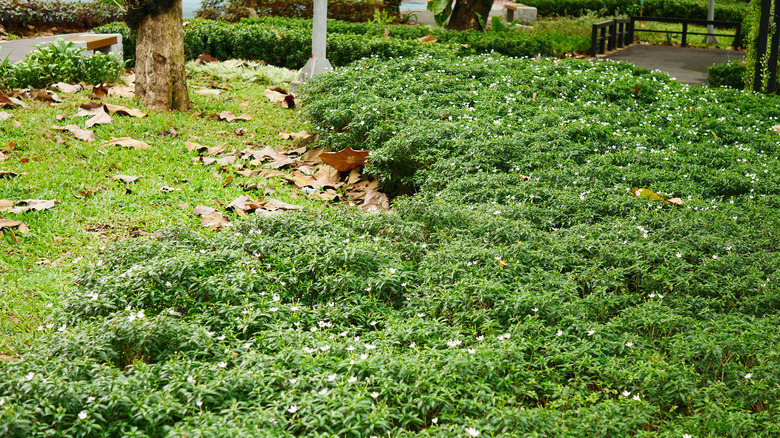The Low-Effort Way To Maintain A Thick, Even Ground Cover
If you love the look of a dense, carpet-like ground cover, then you know how quickly it can get out of control with fallen leaves, twigs, and other backyard debris. While most homeowners would use traditional tools like rakes or garden forks, it is difficult to work with low-lying plants without damaging their surface. The real challenge lies in clearing out any pesky debris without completely hacking away at your plants. But there's a surprisingly simple and low-effort way to keep ground cover looking fresh: using a leaf blower at the right angle and with the right motion.
The trick works because it relies on air, rather than pressure, to move the backyard debris. When you angle your leaf blower at roughly 75 degrees and sweep it in broad, gentle motions, you create an upward draft. This airflow skims the top layer of your ground cover, lifting and removing dead leaves without disturbing essential roots, stem systems, or the soil. And unlike raking, which pulls at the foliage and can uproot or flatten it, this method preserves the plant's structure and prevents bare spots. It's especially useful for thick, mat-forming plants like creeping thyme, sweet woodruff, or ajuga, which tend to trap fallen leaves under their dense growth. The trick itself makes it easier to maintain your ground cover, leaving it looking refreshed and clean. It doesn't add much time to your maintenance schedule either, as it's far more effective than hand-picking or raking the leaves out.
How to use a leaf blower properly for ground cover maintenance
To start, choose a calm, windless day — these conditions will allow you to control the direction of the debris. Set your leaf blower to a moderate level — strong enough to lift leaves, but not so strong that it could damage your greenery. Stand a few feet back from the edge of your garden and angle the blower at about a 75-degree angle, so that the airflow comes across the top of the plants, not directly underneath them. Begin with broad side-to-side sweeps, working slowly across the area. The idea is to "skim" the leaf litter off the surface rather than digging it out. For larger beds, a grid-like pattern moving left to right and moving forward will ensure even coverage without missing spots or overdoing others. Once you reach the edge of your garden bed, bag the leaves (just don't send them to a landfill).
This technique is more than just convenient, as it actually improves the health of the ground cover. Besides protecting fragile stems and shallow root systems from the stress of raking, you're also reducing the risk of compacting the soil, a common issue when raking or walking over these types of beds. Regular use of this method prevents moisture-trapping leaf buildup, which can lead to mold, rot, or pests. A light covering of leaves may be beneficial in reviving your soil, but thicker buildup can further expose your plants to the risk of disease. With minimal effort, this technique gives your landscaping a refreshed look while also letting it thrive naturally.
